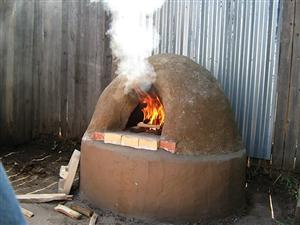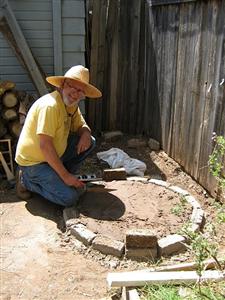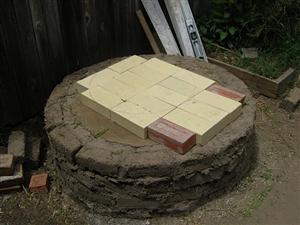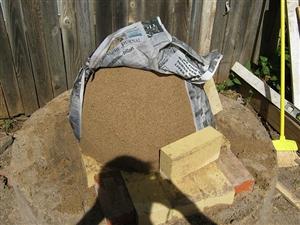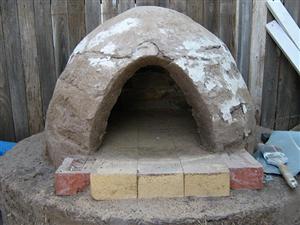By Gaye Levy
Guest writer for Wake Up World
Rocket stoves and outdoor grills are great for cooking in a pot or skillet when the power is down or non-existent following a disaster or a worst case SHTF situation where fuel is either flat-out unavailable or intolerably expensive.
There are some things, though, that cook best in an oven. One solution, of course, is to use a cast iron Dutch oven or camp stove. These are great options, sure, but what about something made from the ground we stand on? I am referring to what is commonly caused a “Mud Oven”. Until my recent visit to the Mother Earth News Fair in Puyallup, Washington, I did not know such a thing existed. Live and learn, right?
What is a Mud Oven and How Does it Work? Mud Ovens have been in use for thousands of years and are made of a clay-sand mixture baked by the wood fire used to heat it. The way they work is that a fire is set, the oven is heated then the cooking is done by retained heat after the fire is removed. Food cooked by this method are cooked slowly and evenly with almost no chance of burning.
[pro_ad_display_adzone id=”110028″]
Mud ovens have many other names: Earth Oven, Clay Oven, Adobe Oven, Bee Hive Oven, Quebec Oven, Roman Oven and El Horno. The difference between these various ovens are in the materials used to build them, what they look like, and where they are used.
I have got to tell you, when I first saw the mud oven I was fascinated. I began thinking about baking breads and pizzas in this primitive but time honored way and wanted to learn more. Imagine my surprise when a Backdoor Survival reader out of the clear blue shared his experience building a mud oven with me!
The Quest for A Mud Oven
Cary from Texas had this to say about his quest to build a mud oven:
I had traveled Arizona and New Mexico visiting places such as Acoma, Taos Pueblo and any other places that had mud ovens.
I remember in the late sixties buying bread baked in these ovens and wanted to duplicate the experience in my own back yard. I also wanted a go to cooking method that was efficient and low cost. The fuel can be anything that burns from nice oak split logs or old pallets torn apart and chopped up. The fire is small and uses very little wood to heat the oven to 500 degrees F.
Then comes the part most people can’t fathom. When the fire burns down to coals you remove it. There is no fire in the oven during cooking. The base becomes a heat sink and the oven walls are 10 inches thick so they hold heat also. You can place your hand on the exterior during peak heat and although hot it will not burn your hand.
The very first firing went as follows. About thirty or more minutes of burning wood and then i removed the coals. Several pizzas were cooked which took about two minutes each. They go directly on the firebrick floor. Then i put two loaves of bread in to bake and removed them 30 minutes later. I hadn’t planned anything past that so i put the door back in place while i made up a pot of dry pinto beans, yes dry, with plenty of water and some seasoning.
I had little hope for this but tried it anyway. I made some mud to seal the door and walked away at 2:30 that afternoon. I checked the oven the next morning and it was still hot and the beans had cooked to a creamy texture and were delicious.
How Do You Build a Mud Oven?
There are lots of instructions on the internet but first, follow along as Cary shares his construction via some great photos (used with his permission, of course).
Base for heat sink being laid out.
As for the building of a mud oven the most critical mindset to have is you can fail and lose nothing. Reuse the old mud and start over.
Walls for heat sink homemade adobe brick.
The second most critical mindset is the oven doesn’t have to be perfect and probably won’t be. You only have a few rules and they deal with clay and sand content of the mud which is basically adobe. Remember, this is 3000 year old technology and if they made it work, so can you.
Solid adobe plug that hold massive amounts of heat and radiates out during cooking
Fire brick cooking floor. The ancients just used the mud floor.
Damp play sand in the shape of a beehive. You build mud over this form.
Door cut out and sand removed. The oven gets another 31/2 inches of adobe with wood shavings as an insulator. Then a final 1 inch finish coat.
So, the first step is do some research, read Kikos book (see below) and find some friends to help with the heavy work. I built mine at 68 years of age with no help. I wouldn’t do it again without at least one helper. If you are young and in good shape then go for it but remember mud gets heavy and you have to mix a lot of it.
Good luck.
The Final Word
Most sources, including Cary, consider the best book on mud ovens to be ”Build Your Own Earth Oven: A Low-Cost Wood-Fired Mud Oven; Simple Sourdough Bread; Perfect Loaves” by Kiko Denzer. In addition, there are some pretty decent instructions for building your own mud oven at the Mother Earth News website in the article Build Your Own Wood-fired Earth Oven.
Mud ovens can be built in all sizes and take little in the way of time to maintain. Furthermore, my guess is that these ovens were the precursor to the modern day slow cookers that we fondly call the “crock pot”. And in closing what does Cary say?
“This thing cooks anything and left closed overnight will cook cast iron beans and stews to last a week. You can hold the required scrap wood for the burn in two hands. Fire is removed before cooking and holds heat for a good 24 hours with door closed. Ancient technology. Not for everyone. Requires skill to build but doable for the DIY.”
Why not go for it and build one yourself? At the very least, print out the instructions and keep them with the rest of your survival documents. And me? SH and plan to build our own mud over with help from friends next spring.
Enjoy your next adventure through common sense and thoughtful preparation!
Gaye
About the Author
Gaye Levy lives and teaches the principles of a sustainable, self-reliant and stylish lifestyle through emergency preparation and disaster planning. She does this through her website at BackdoorSurvival.com, an online preparedness blog that provides lifestyle tools, tips, and thoughts to guide you through the back door of life in the 21st century. With an emphasis on prepping and survival, she writes about and shares practical, thoughtful, and inspirational tools for survival in uncertain times.
Backdoor Survival is currently listed on the Survival Top 50. In addition, Gaye is a frequent guest on the Preparedness Radio Network and the soon to be author of a book on 21st century preparedness. Also known as SuvivalWoman, Gaye speaks her mind and delivers her message with optimism and grace, regardless of mayhem swirling around us.
You can find Gaye through her website at Backdoor Survival, on the Backdoor Survival Page on Facebook, and as Survival Woman on Twitter.
[pro_ad_display_adzone id=”110027″]

